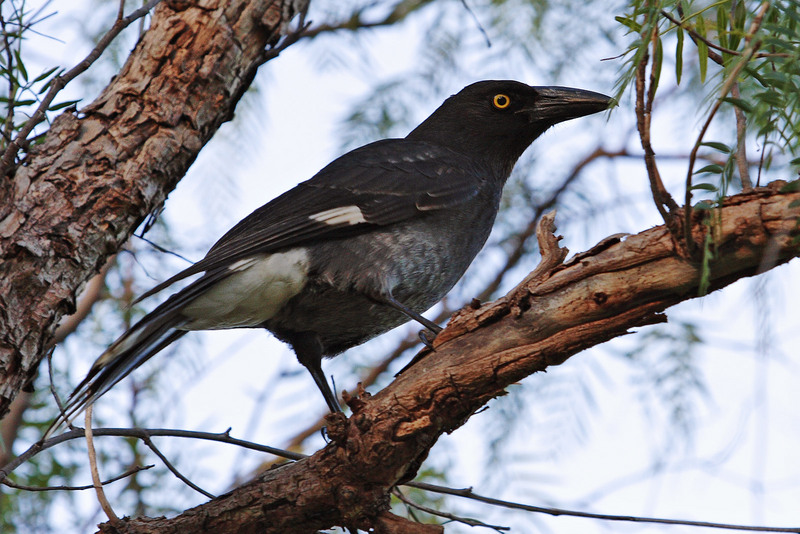|
| 질의: description | 결과: 9559번째/10150 | |
Pied Currawong (Strepera graculina) - Wiki
| 제목: | Pied Currawong (Strepera graculina) - Wiki
| |

| 해상도: 1600x1067
파일크기: 529058 Bytes
등록시간: 2007:12:03 09:54:55
|
Pied Currawong
From Wikipedia, the free encyclopedia
Order: Passeriformes
Family: Artamidae
[Photo] Pied Currawong (Strepera graculina) in a peppercorn tree, Swifts Creek Victoria. Author: http://en.wikipedia.org/wiki/User:Fir0002 | Permission is granted to copy, distribute and/or modify this document under the terms of the GNU Free Documentation License, Version 1.2 or any later version published by the Free Software Foundation; with no Invariant Sections, no Front-Cover Texts, and no Back-Cover Texts. A copy of the license is included in the section entitled "GNU Free Documentation License". |
The Pied Currawong, Strepera graculina is a common omnivorous songbird of eastern Australia. Its specific name is derived from the Latin graculina, resembling a Jackdaw, though Grackles of the genus Gracula are members of the Sturnidae.
Though crow-like in appearance and habits, it is only distantly related to true crows, instead it belongs to the family Artamidae, together with the closely related Australian Magpie and the butcherbirds. Like all these birds, it has adapted very well to urbanization.
Description
The Pied Currawong is generally a black bird with white in the wing, undertail covets, the base of the tail and (most visibly) the tip of the tail. It also has yellow eyes. Size is about 40 to 50 cm. Along with magpies and butcherbirds, it has one of the most hauntingly beautiful caroling calls of any Australian songbird, and is eclipsed, perhaps, only by the Grey Shrike-thrush and the lyrebirds.
Subspecies
Six subspecies are currently recognised:
- Strepera graculina graculina
- Strepera graculina ashbyi - Western Victorian Pied Currawong
- Strepera graculina crissalis - (Vulnerable) - The Lord Howe Island Currawong appears to have adapted well to human habitation on Lord Howe Island, though the population is small overall, somewhere around 70 birds.
- Strepera graculina magnirostris
- Strepera graculina robinsoni
- Strepera graculina nebulosa
Distribution and habitat
It is common in woodland, rural and semi-urban environments throughout eastern Australia, from Cape York to western Victoria and Lord Howe Island Lord Howe Island, where it occurs as an endemic subspecies. It seems to have adapted well to European presence, and has become more common in some urban areas such as Sydney.
Unlike many birds, Pied Currawongs have suffered little from European occupation of the land. Settlers and successive generations have replaced much of the natural woodland and forest with vast artificial grasslands, where Currawongs are seldom seen. Scattered patches of remaining bush appear to be sufficient for their needs and the provision of irrigated waypoints along their rambling migration routes has encouraged them to take up residence in areas where they previously only overflew.
The effect of this on smaller birds that are vulnerable to nest predation is controversial: several studies have suggested that Pied Currawongs have become a serious problem, but the truth of this widely held perception remains to be established. They appear to thrive on berries of some introduced species, some of which themselves are pests, such as the Camphor laurel (Cinnamomum camphora).
Behaviour
Pied Currawongs are generally tree dwelling, hunting and foraging some metres above the ground, and thus able to share territory with the ground-foraging Australian Magpie.
Diet
The Pied Currawong is omnivorous, eating fruit and berries as well as preying on many smaller birds and animals. They will often scavenge, eating scraps and rubbish and can be quite bold when seeking food from people.
Nesting
Pied Currawongs build nests of sticks high in trees in spring, laying three eggs.
Voice
The loud distinctive call has been translated as Kadow-Kadang or Curra-wong. Birds also have a high-pitched but loud whistle. The endemic Lord Howe Island subspecies has a distinct, more melodious call.
http://en.wikipedia.org/wiki/Pied_Currawong
| The text in this page is based on the copyrighted Wikipedia article shown in above URL. It is used under the GNU Free Documentation License. You may redistribute it, verbatim or modified, providing that you comply with the terms of the GFDL. |
|
^o^
동물그림창고 똑똑전화 누리집
^o^
|
|